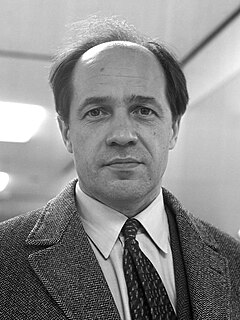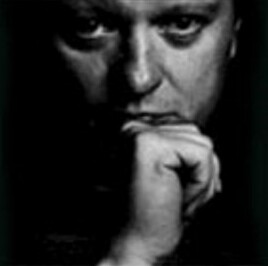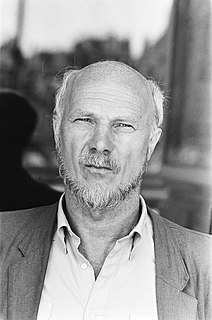Related Research Articles

Orchestration is the study or practice of writing music for an orchestra or of adapting music composed for another medium for an orchestra. Also called "instrumentation", orchestration is the assignment of different instruments to play the different parts of a musical work. For example, a work for solo piano could be adapted and orchestrated so that an orchestra could perform the piece, or a concert band piece could be orchestrated for a symphony orchestra.

Pierre Louis Joseph Boulez CBE was a French composer, conductor, writer and founder of several musical institutions. He was one of the dominant figures of the post-war classical music world.

Chamber music is a form of classical music that is composed for a small group of instruments—traditionally a group that could fit in a palace chamber or a large room. Most broadly, it includes any art music that is performed by a small number of performers, with one performer to a part. However, by convention, it usually does not include solo instrument performances.

David Vickerman Bedford was an English composer and musician. He wrote and played both popular and classical music. He was the brother of the conductor Steuart Bedford and the grandson of the composer, painter and author Herbert Bedford and the composer Liza Lehmann.

Pli selon pli is a piece of classical music by the French composer Pierre Boulez. It carries the subtitle Portrait de Mallarmé. It is scored for a solo soprano and orchestra and uses the texts of three sonnets of French symbolist poet Stéphane Mallarmé and single lines from two of his other poems. At over an hour, it is Boulez's longest work.

IRCAM is a French institute for science about music and sound and avant garde electro-acoustical art music. It is situated next to, and is organisationally linked with, the Centre Georges Pompidou in Paris. The extension of the building was designed by Renzo Piano and Richard Rogers. Much of the institute is located underground, beneath the fountain to the east of the buildings.

Philippe Manoury is a French composer.

Theo Loevendie is a Dutch composer and clarinet player.
Kontra-Punkte is a composition for ten instruments by Karlheinz Stockhausen which resolves contrasts among six instrumental timbres, as well as extremes of note values and dynamic levels, into a homogeneous ending texture. Stockhausen described it: "Counter-Points: a series of the most concealed and also the most conspicuous transformations and renewals—with no predictable end. The same thing is never heard twice. Yet there is a distinct feeling of never falling out of an unmistakable construction of the utmost homogeneity. An underlying force that holds things together—related proportions: a structure. Not the same Gestalten in a changing light. But rather this: various Gestalten in the same light, that permeates everything".
Kreuzspiel is a composition by Karlheinz Stockhausen written for oboe, bass clarinet, piano and four percussionists in 1951. It is assigned the number 1/7 in the composer's catalogue of works.
Harry Sparnaay was a noted Dutch bass clarinetist, composer, and teacher.
Dai Fujikura is a Japanese-born composer of contemporary classical music.
John Bruce Yeh is an American clarinetist. He has been the assistant principal clarinetist and E-flat clarinetist of the Chicago Symphony Orchestra since 1977. Yeh is the founder and director of the chamber ensemble, Chicago Pro Musica, whose first recording, Stravinsky's L'Histoire du soldat, won the 1985 Grammy Award for the Best New Classical Artist.

The Chamber Symphony No. 1 in E major, Op. 9 is a composition by Austrian composer Arnold Schoenberg.
Rotae Passionis is a piece for mixed chamber ensemble by the American composer Christopher Rouse. It was commissioned by Boston Musica Viva and completed in 1983, when the work was first performed. It is dedicated to Carl Orff, who died the previous year.
A Garland for Dr. K. is a set of eleven short compositions created in 1969 for the celebration of the eightieth birthday of Dr Alfred Kalmus, the director of the London branch of Universal Edition. It is also the title of an album containing these eleven pieces of music, recorded in 1976.
A Symphony of Three Orchestras is an orchestra composition by the American composer Elliott Carter. The work was commissioned by the New York Philharmonic through a grant from the National Endowment for the Arts. It was composed from June through December 1976 and was first performed in New York City on February 17, 1977 by the New York Philharmonic under the conductor Pierre Boulez. The composition is dedicated to Boulez and the New York Philharmonic.
The Double Concerto for Harpsichord and Piano with Two Chamber Orchestras is a composition by the American composer Elliott Carter. The work was commissioned by the Fromm Music Foundation and is dedicated to the philanthropist Paul Fromm. It was completed in August 1961 and was first performed at the Metropolitan Museum of Art's Grace Rainey Rogers Auditorium on September 6, 1961. The premiere was performed by the harpsichordist Ralph Kirkpatrick and the pianist Charles Rosen under the conductor Gustav Meier.
Alain Damiens is a French classical clarinetist.

Dérive 1 is a composition for six-part instrumental ensemble by French composer Pierre Boulez. It was composed in 1984.
References
- 1 2 Pappenheim, Mark (26 June 1993). "Playing to the gallery: David Bedford was banned because he would keep bringing the audience into it". The Independent . Retrieved January 24, 2012.
- ↑ Bedford, David (1975). With 100 Kazoos. Universal Edition UE 15478.